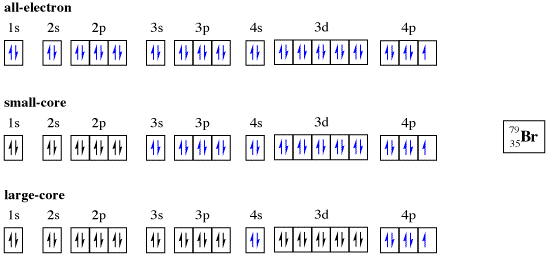Effective Core Potentials (ECP)
Effective core potentials (ECPs) are used to replace the inner (core) electrons of atomic and molecular systems by an effective potential and treat only the valence electrons explicitly in quantum mechanical calculations. This leads to substantial reductions in computational effort and also allows for an efficient treatment of relativistic effects. The separation into core and valence electrons is by no means obvious in heavier elements, and some experimentation with larger and smaller cores in comparison to either experimental results or those obtained from all-electron calculations (with appropriate treatment of relativistic effects) is required. As a consequence "small-core" and "large-core" ECPs are available for a variety of elements and it depends on the question at hand to decide on one of these choices.
Taking bromine as an example, the all-electron calculation treats all 35 electrons explicitly (shown in blue below). A "small-core" ECP is available replacing the 10 innermost electrons (shown in black below), leaving the remaining 25 electrons to be treated explicitly. Including the complete block of 3s3p3d electrons in the ECP leads to a "large-core" ECP replacing 28 electrons. This latter choice leaves the 4s4p electrons to be treated explicitly:

Frequently used ECPs available in many quantum chemistry software packages are: